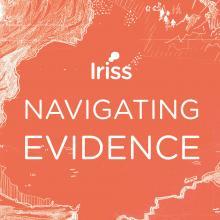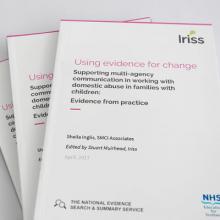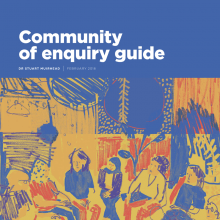This Insight focuses on the transition to adulthood for young people with autistic spectrum disorder.
Key points
- The transition to adulthood is particularly challenging for young people with ASD. This is frequently exacerbated through the withdrawal or attenuation of support, and by limited communication between agencies.
- To improve the experience and outcomes for this group, social services should:
- Track the number of young people with ASD, allowing local authorities to plan appropriate services
- Train social services staff to understand and provide support for people with ASD
- Address the issue of young people with ASD 'falling between the gaps' of specialist social services
- Identify a single point of contact to support the young person through the transition.
- Full involvement of the young person in early transition planning with a multidisciplinary team, including social services, is crucial. Transition goals should be tailored to the individual and emphasise the development of social, vocational and communication skills.
Policy context
Autistic Spectrum Disorder (ASD) is a set of developmental disorders, including autism and Aspergers Syndrome (AS), characterised by three main areas of difficulty, known as the triad of impairments (Wing and Gould,1979). These are difficulty with social communication, social interaction and social imagination. Other common traits of people with ASD are a love of routines or repetitive behaviour and restricted interests. Many people with ASD experience some degree of heightened or reduced sensory sensitivity and can also experience perceptual problems. ASD is also frequently accompanied by learning disabilities. ASD is a spectrum disorder as the condition affects people in different ways and to different extents. It is important to acknowledge that although those with high functioning autism and AS may have average or above average intellectual capabilities, the nature of the impairments described above means that they still often have requirements for high levels of support. Throughout this report, the term ASD is used and is intended to include those throughout the autistic spectrum.
The unique nature and challenges of ASD and the fact that people with the condition often fall between the gaps of services has contributed to ASD being the first disability with specific legislation with the passing of the Autism Act in England in 2009. The Autism (Scotland) Bill was introduced to the Scottish Parliament in 2010 but has not yet been passed.
Transitions and dealing with change can be challenging for everyone. They are particularly difficult, however, for people with ASD who often rely on predictability to make sense of their environment and can find it hard to imagine alternatives (Daly, 2008; Allard, 2009). The transition from school to adulthood and adult services can be especially testing because children with ASD often receive a very good level of support and understanding throughout school, only to find this is withdrawn, sometimes entirely, when they reach school leaving age (Daly, 2008).
The Education (Additional Support for Learning) (Scotland) Act (2009) has a very broad definition of Additional Support Needs, which should cover support for children with ASD (with or without learning disabilities), including appropriate transition planning. However, in practice, children with ASD are often overlooked. The extent of this problem can be illustrated by the fact that 32% of appeals to the ASN Tribunal for Scotland in 2009-10 concerned children and young people with ASD, despite their composing only 8% of the population defined as having Additional Support Needs.
The Autism (Scotland) Bill 2010 specifically acknowledges that the failure to provide young people with ASD with transition support can have devastating consequences for their futures. This results not only in a personal cost to the individual but a high, and avoidable, societal financial cost as services are often accessed later at a point of crisis when a greater level of support is required (National Audit Office, 2009).
The evidence
The reality of the transition process
Poorly managed transitions are common. In a recent Scottish survey, 95% of young people aged 15 to 25 said that they needed help with planning transitions, yet over half had received no support at all (Reid, MacBean and Charles, 2009).
The Scottish Intercollegiate Guidelines Network (SIGN, 2007) recommends that for people with ASD 'particularly in regard to periods of transition, there should be multiagency, life-long planning'. However, there is a frequent lack of communication not only between education departments and social services but also between adults and children's services (Daly, 2008). This is often true even when children have received a timely diagnosis of ASD and are already receiving services. This lack of communication between agencies can exacerbate the problem of complete or partial withdrawal of support at the age of 18 (Daly, 2008).
Falling between the gaps
A related issue concerns the fact that although people with ASD often have profound needs for support, many (especially those with high functioning autism or AS) do not qualify for support from any of the specialist services offered by a local authority. Typically they fall between the mental health and learning disabilities teams within adult services (Daly, 2008), often resulting in neither team taking responsibility for the young person in transition. This issue is widely acknowledged but very few local authorities have a strategy in place to tackle it (Daly, 2008). The lack of a single point of contact often leads to parents shouldering this burden, placing greater stress on the family as a whole (Allard, 2009).
The transition to adult services is most likely to be successful if planning begins early and fully involves the young person and their family (Hendricks and Wehman, 2009). Delays in planning (or not planning at all) are likely to decrease the chance of obtaining appropriate funding and increase the chance that the young person will have to wait, sometimes for a considerable period, for an appropriate placement, either within education, employment or a service (Allard, 2009).
Limited by expectations
Several studies emphasise the fact that young people with ASD should be presented with the full range of options available to them rather than a restricted range based on the young person's perceived limitations (Hendricks and Wehman, 2009). Allard (2009) also notes the importance of planning support for areas of life other than employment or continuing education. These 'quality of life' areas are often overlooked though they are critical for good mental health and independence, and include relationship counselling, leisure activities and financial skills.
Community integration is a goal for many young people with ASD and should be a critical component of the transition planning process (Hendricks and Wehman, 2009). This can be enhanced through interventions to increase safety skills and social functioning and to reduce inappropriate behaviour. Services such as social skills support, befriending and participation in social groups, are particularly desired by those with ASD but rarely provided (Daly, 2008).
Related to both quality of life and community integration is support towards independent living. Currently 41% of adults with ASD live at home with their parents (Daly, 2008), a situation which is unsustainable in the longer term.
Invisible to social services
Planning is made more difficult for local authorities due to the lack of awareness of the numbers of young people with ASD likely to be making the transition to adult services. This information is currently recorded by only 40% of Scottish local authorities (Daly, 2008). In addition, based on calculations of prevalence of ASD (1 in 100 people are affected) and Scottish Government figures of 4,900 pupils in Scotland being on the autism spectrum, Reid and colleagues (2009) suggest that over one quarter of children with ASD in schools (around 2000 in total) are not being recognised.
Implications for practice
It is clear that very real difficulties exist for young people with ASD facing the transition to adulthood. Evidence highlights a number of recommendations about how this can be addressed.
Early planning and communication
Early planning with input from a multidisciplinary team, including representatives from social services, is key to a successful transition (SIGN, 2007; Daly, 2008; Allard, 2009; Reid et al, 2009). Local authorities should ensure there is effective communication between these agencies, particularly adult and children's services (Daly, 2008; Reid et al, 2009). This would be particularly facilitated by a single point of contact in the local authority who could take overall responsibility for the young person's transition, lifting that burden from the parents and ensuring good communication between the relevant agencies to prevent the young person falling between the gaps (Daly, 2008; Allard, 2009). Rather than reducing or entirely withdrawing support at this crucial time it is recommended that 'social work contact with families should be instituted or extended during periods of transition' (SIGN, 2007).
Training
It is vital that the person acting as a single point of contact, along with others who provide services to individuals with ASD have appropriate training that allows them to understand the unique challenges for people with this condition (Allard, 2009).
A review of a three-year project to provide basic training to social work staff in Scottish Local Authorities showed that this training had been offered to only 4% of social work staff over the lifetime of the project. Those offered the training increased their knowledge but it was identified that further more specialised training was still required (Broach at al, 2004).
Defining goals and expectations
Hendricks and Wehman (2009) discuss how transition goals for young people with ASD should be defined. They suggest that these should be tailored to the individual and have an emphasis on the development of skills such as social skills, communication skills, vocational skills and also leisure activities. Real effort should be made to allow the young person to contribute to planning the transition, regardless of their level of ability. Systems such as the Picture Exchange Communication System (PECS) or Makaton can be useful in allowing the young person to express their views (Reid, 2007). This can help to ensure that the planning for the young person's future is not constrained by perceived limitations or by stereotypes (eg that a young person with ASD would be suited to working with computers) (Allard, 2009; Hendricks and Wehman, 2009).
While expectations should be high, they should also be realistic (Allard, 2009). Whatever the aspirations of the young person, for example in continuing education or seeking employment, they potentially will have unique difficulties in achieving and maintaining these goals and will require support to do so (Allard, 2009). It is also very important to simultaneously facilitate 'quality of life' goals. The need for social skills training is very high, particularly for those with high functioning autism or AS (Reid, 2007). Training and support for independent living should also be offered. Three quarters of parents believe that significant daily or 24 hour support would be required for their child with ASD to live independently, including support with personal care, preparing meals and financial skills (Daly, 2008). Recently, Glasgow City Council has produced a practical guide to housing provision for people with ASD (Glasgow City Council, 2010), which has been hailed as an example of good practice by the National Autistic Society (Reid et al, 2009)
Early planning is particularly important because, due to their difficulties with social imagination, it can be very hard for a young person with ASD to grasp abstract concepts, so they should be given the opportunity to try out potential options for their future as well as being made aware of them (Allard, 2009; Hendricks and Wehman, 2009). This can include opportunities to experience meaningful work experience, to trial services and groups and to build up attendance at services or further education gradually. Careful planning to account for and prevent problems that might arise as well as building in contingencies for potential problems is very important as it can be hard to redeem a placement once it has broken down (Allard, 2009).
Availability of services
Although this review is concerned with transitions to adulthood rather than adult services per se, it is important to acknowledge some very real limitations with the available services for adults with ASD that could prevent the success of even the most well-planned transition.
A recent survey of people in Scotland with ASD and their families found that 95% said that more services were needed locally for people with ASD, while 48% rated their experiences of available services as poor or very poor (Reid et al, 2009). Key gaps identified include social support, advocacy, self-directed support, employment support or training and short breaks or respite. Another study found that one quarter of Scottish local authorities do not offer any ASD-specific services at all (Daly, 2008). Guidance on commissioning services for people with ASD has recently been published by the Scottish Government and will be useful reading for those who wish to know more about addressing this issue (Scottish Government, 2008).
'The failure to provide young people with autistic spectrum disorder with transition support can have devastating consequences for their futures. This results not only in a personal cost to the individual but a high, and avoidable, societal financial cost.'
References
- Allard A (2009) Transition to adulthood: inquiry into transition to adulthood for young people with autism, London: National Autistic Society/ The All-Party Parliamentary Group on Autism
- Autism (Scotland) Bill 2010
- Broach S, Chalmers S, Laurance K et al (2004) Autism: improving understanding. A review of work undertaken by the The National Autistic Society to provide basic autism awareness training to Social Work staff under Section 9 of the Social Work (Scotland) Act 1968, London: The National Autistic Society
- Daly J (2008) I exist: the message from adults with autism in Scotland, Glasgow: The National Autistic Society Scotland
- Glasgow City Council (2010) Practical guide for Registered Social Landlords (RSLs): Housing and Autism Spectrum Disorder (ASD)
- Hendricks DR and Wehman P (2009) Transition from school to adulthood for youth with autism spectrum disorders: review and recommendations, Focus on Autism and other Developmental Disabilities, 24 (2), 77-88
- National Audit Office (2009) Supporting people with autism through adulthood, London: The Stationery Office
- Reid B (2007) Moving on up: Negotiating the transition to adulthood for young people with autism, London: The National Autistic Society
- Reid B, MacBean R and Charles R (2009) We exist: A bill for autism, a bill for Scotland, Glasgow: The National Autistic Society Scotland
- Scottish Government (2008) Commissioning services for people on the autism spectrum: Policy and practice guidance, Edinburgh: Scottish Government
- Scottish Intercollegiate Guidelines Network (2007) Assessment, diagnosis and clinical interventions for children and young people with autism spectrum disorders: a national clinical guideline, Edinburgh: SIGN
- Wing L and Gould J (1979) Severe impairments of social interactions and associated abnormalities in children: epidemiology and classification, Journal of Autism and Developmental Disorders, 9, pp11-29




